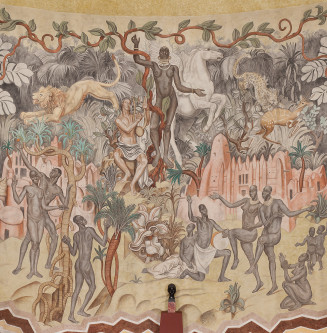Louis Bouquet
The fresco that decorates the Africa salon, located in the south-west angle of the Hall of Honour, was made by the Lyon-based painter Louis Bouquet (1885-1952), whose aim was to illustrate the cultural and intellectual contributions made by Africa.
Born on December 6th 1885, died February 25th 1952 in Lyon, Louis Bouquet was a student at the École des Beaux-Arts in Lyon from 1903. After winning the Prix de Paris in 1907, he joined the workshop of painter Fernand Cormon at the École des Beaux-Arts in Paris. During the years he was studying, he became friends with the sculptor Alfred Janniot. But it was encounters with artists Joseph Bernard and Marcel-Lenoir that would leave the deepest impression on him. From the former, he took the illustration of powerful female figures, and from the second, attention paid to illustration and outline.
In 1911, he worked with Maurice Denis on the L’Âge d’or decoration on the staircase at the Hôtel du Prince Wagram in Paris, and the ceiling of the Théâtre des Champs-Élysées in 1912. It was on this occasion that he met his future wife Jeanne-Marie dos Santos, a student of Denis. The canvas paintings Pietà (1911) and Orante (1912) reveal the influence Denis had on Bouquet: the figures are extremely simplified and the decorative dimension is affirmed by the flat colours and accentuated contours. He worked with Maurice Denis again in 1915 on the decorations for the Église Saint-Paul, near Geneva.
Wood engraving as a preferred means of expression
Bouquet was not mobilised during World War 1 for health reasons, and in 1917 he published Le livre de ceux qui sont restés (the book of those who stayed behind), containing 9 wood engravings with captions. Updated by Paul Gauguin in the late 19th century to suit the tastes of the time, by the end of the war wood engraving had become Bouquet’s preferred means of expression. Tightly framed female nudes were his favourite subject, but Bouquet also used this technique to illustrate religious and poetic works for the Editions de La Sirène.
On the death of his wife in 1919, Bouquet travelled to Tunisia, which enabled him to enrich his colour palette. In 1920, he took part in the first exhibition by the Ziniars group of artists, of which he was one of the founder members, at Alfred Poyet’s Galerie Saint-Pierre in Lyon. At the Salon d’Automne in 1921, Bouquet presented the painting Tristan et Iseult, considered to be one of his masterpieces. The following year he married the sister of his deceased wife, Madeleine dos Santos. Between 1922 and 1923, he exhibited alongside Henri le Fauconnier in Lyon and had two personal exhibitions at the Parisian Billet gallery.
Initiation into Art Deco
During this time, Louis Bouquet was initiated into the decorative arts. For the second exhibition organised by the publication La Douce France at the Barbazanges gallery in May 1923, he exhibited a varied set of works, comprising a decorative panel, a tapestry cartoon, a stained-glass window card and a mosaic. In 1925, he was a member of the admission committee for the International Exhibition of Decorative and Industrial Arts, where he took part in the pictorial decoration of the Studium Louvre pavilion built by Albert Laprade for the Grands Magasins du Louvre. In 1929, he applied for the post of professor of decorative composition at the École des Beaux-Arts in Cairo.
Recommended by the architect Tony Garnier and his friend Janniot, Bouquet was solicited by Laprade to create the fresco for the Africa Salon at the Musée Permanent des Colonies. Bouquet became familiar with the fresco technique working with Marcel-Lenoir and was also able to observe Bourdell’s know-how when working on the Théâtre des Champs-Élysées.

Legende
Louis Bouquet's fresco in the Africa Salon
Credit
© Palais de la Porte Dorée

Louis Bouquet's fresco in the Africa Salon
© Palais de la Porte Dorée
In 1933, he joined most of the museum’s artists for the decoration of the grand staircase at the new town hall in Puteaux. From 1933 to 1934, he produced some of the frescoes at the Église du Saint-Esprit in Paris, built out of reinforced concrete by Paul Tournon in what represented the biggest pictorial programme of the inter-war period in France.
A multiplication of media and collaborations
In addition to his wall décors, Bouquet devoted a large share of his activity to portrait art. Throughout his career, Bouquet painted many portraits of his family and close friends, which testify to a concern for realism. On completion of work on the Musée des Colonies for example, Bouquet produced a group portrait of Laprade surrounded by his fellow artists, including Bouquet himself, in front of the building. He also took part in the exhibitions Le Retour au sujet (1934) and Le réalisme et la peinture (1936) organised by the Billiet-Vorms gallery.
Between 1935 and 1950, Bouquet worked on several occasions with the architect Michel Roux-Spitz. They created the decoration for his Parisian apartment in the rue Littolf, the huge fresco in the reception hall at the Hôtel des Postes in Lyon, along with the frescoes Les Éléments, les Sciences et les Arts at the Ecole Technique in Limoges and Le Voyage de l’homme en blanc for his own town of Dinard.
The post-war period proved difficult for Bouquet however, and he struggled to obtain orders. In 1948, he reluctantly accepted the modest project of restoring the Église Saint-Pierre du Petit-Montrouge in Paris. He did manage to secure an order for decorating the ceiling of the atrium at the Salle Molière in Lyon. Bouquet suffered a heart attack on the site in July 1951, leaving his work Le Triomphe de Pégase unfinished. The painter died several months later on the Île Barbe, where his workshop was located.



